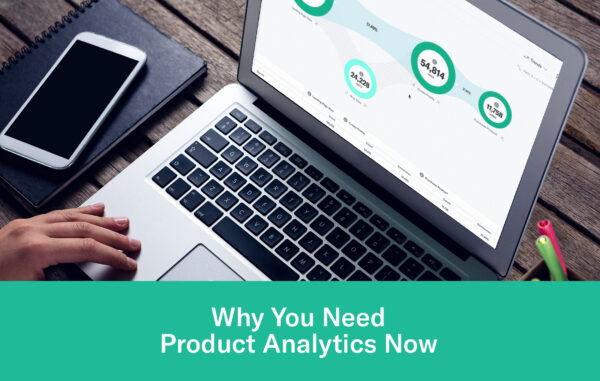A lot gets lost in translation when we talk about analytics, and Product Analytics is no exception. We talk about how Product Analytics tools can help you build a better product, how they can help you improve UX, how they can help you better understand customers.
And all of that is true.
- Product Analytics enables companies to build the products that people want and do it quickly. That means more revenue in less time.
- Product Analytics helps increase conversion rate. That means faster growth and more revenue, at a lower cost.
- Product Analytics ensures product teams can reduce churn, increasing retention and lifetime value. That means revenue and MRR are protected for the long term.
But what we don’t talk about enough is the whole point of all that: How those things work together to generate more revenue for your company.
That’s the reason analytics exist. Companies turn to analytics to help them generate more revenue, more quickly. That means more customers, more upsells and upgrades, faster conversion, and lower churn—that’s the recipe for more revenue.
Indicative and the broader Product Analytics ecosystem exist to help product teams create better products that enable revenue growth.
How to Drive Revenue With Product Analytics by Building a Better Product
While marketing and sales are important, in today’s product-led growth market, your actual product is the most effective and valuable lever at your disposal for driving revenue growth. That’s why there’s so much focus on building better products and better customer experiences—that’s how you grow.
Building better products absolutely depends on data. Product teams need real-time access to accurate, useful customer data in order to build products that convert, upsell, and retain customers all on their own.
Customer data enables product teams to identify the product’s ‘Aha’ moment, for example—where in the customer journey it lies, which features can trigger it, and the goals that lead customers to it. Product Analytics help identify a product’s most engaged and valuable users, along with the key behaviors and characteristics that define them.
Increase Conversion With Multipath Funnels
Building out a customer funnel is the number one way to increase conversion. In order to get more customers to the point of converting, you need to understand the path they take to get there.
The problem is that too many companies approach this by laying out their ideal customer journey and broadly trying to push people through it. That stems, in large part, from a lack of real-time useful data and a lack of access to that data throughout the teams that need it—including sales, marketing, and product, among others.
Instead, Product Analytics allows you to view the actual journey customers take to conversion via customer funnel analysis.
More advanced funnel tools (like Indicative’s unique Multipath Funnel feature) make quick work of answering key questions like:
- What product features make customers more likely to convert?
- Which is the optimal path to conversion?
- How are customers engaging with a new product feature?
Once you have that kind of perspective, identifying and eliminating friction that spoils or slows conversions is pretty straightforward for product and marketing teams.
Of course, it isn’t all about the initial conversion for many businesses these days. Converting on upgrades, upsells, and turning free users into paid ones is just as important for driving revenue growth.
An advanced Multipath Funnel tool can help with that, too, allowing you to:
- Compare paid conversion rates for multiple paths at the same time
- Identify high-performing or low-performing steps between events
- Explore users who are most likely to convert to paid
Here’s an Example:
At the beginning of the COVID-19 pandemic, BentoBox—a B2B2C company that empowers restaurants by helping them build and maintain an online delivery service— gave restaurants an option to add a $1.99 “Covid Relief Fee” to orders.
Following the release of the new feature, they needed to be sure the fee wouldn’t cause consumers to balk and conversions to crater.
The team turned to Indicative’s multipath funnel tool to answer their core question: “Can we add this and help restaurants drive revenue at a critical time?” Or would the new feature cause customers to balk and end up costing revenue?
They analyzed conversion funnels and ensured the feature would be ultimately beneficial for restaurants—and it was. The fee didn’t impact conversion rates at all, but it generated nearly $550,000 for BentoBox customers since its release.
Drive Adoption With Segmentation
The average company wastes 50-80% of new signups by failing to focus on adoption and retention. That’s a whole lot of revenue left on the cutting room floor.
Refocusing your organization on driving higher product adoption can help recover a good chunk of that lost revenue, by decreasing time-to-value for your customers, combatting churn, and growing average revenue per user (ARPU).
User segmentation is the best way to do that because it allows product teams to dig into the common behaviors and characteristics behind your most valuable customers. Using the Segmentation tool in Indicative, you can identify just what those behaviors and characteristics are. You can segment users by:
- Engagement
- Frequency of usage
- Total time spent in the product
- Usage of specific features
- Inactivity
- Churn vs. retention
- And more!
That makes it a lot easier to encourage those behaviors across the board, driving adoption and speeding more users to their ‘Aha’ moment, faster.
You may find, for example, that the majority of users who adopt the product fully and engage with it regularly began using a specific feature in their first two days with the product.
Taking steps to encourage more users to explore that feature more quickly after signup, then, can boost adoption rates.
Here’s an Example:
Back in 2019, Prezi—the global presentation software company—launched a new product: Prezi Video. To facilitate a smooth roll-out, they needed to be able to see, in real-time, whether users were adopting the new feature, how they were using it, and which power users might be able to offer more insight into new product adoption.
The product manager in charge of the launch kept a keen eye on those user flows across various segments of users to monitor how adoption and usage of the new feature varied across different groups.
The team was able to ensure users adopted the new feature, identify points of friction that halted or slowed adoption, and make agile changes to alleviate friction and speed adoption. They even identified a few power users to interview for more insight into the new product’s performance.
Kick Churn to the Curb (and Increase Retention) With Cohort Analysis
Reducing customer churn hinges on a few key things:
- Diagnosing the behaviors and events that lead to churn
- Identifying the characteristics that correlate with retention
- Understanding commonalities among the customers who churn
Having access to that information enables the product team to create behavioral nudges to help new customers make quicker buying decisions, making churn less likely all while boosting lifetime value for the product and supporting product growth over time.
Cohort analysis is your best ally here.
For example, here’s how that might work in practice:
By configuring your revenue mapping and selecting ‘Revenue’ as a Target Behavior in Indicative’s Cohort Analysis tool, you can determine how different behavioral cohorts affect the bottom line—making it easier to attract more of the kind of customers likely to stick around in the first place.
You can also optimize your onboarding efforts by selecting ‘First-Time Behavior’ and determine which behavioral characteristics drive customer retention by selecting ‘Recurring Behavior’.
A few other ways cohort analysis can help banish churn and boost retention:
- Find your most profitable acquisition channels by uncovering the relationship between acquisition channel and metrics like revenue and lifetime value
- Eliminate churn-driving friction in product updates with real-time analysis of launch cohorts
- Analyze the behavior and usage patterns of your most engaged customers and reverse engineer that data into greater engagement across your user base
In practice, that can look different based on your product. For example, one ecommerce company that used Indicative created a cohort of repeat purchasers to look at whether certain products correlate with repeat purchases. They can use that information to prioritize product promotion, segment customers who purchase those products, and more.
An Indicative customer in the educational SaaS space uses cohort analysis to identify when enrolled users tend to drop-off—so they can dig deeper into why drop-off happens and how they can re-engage users at that point.
Why Indicative Is the Product Analytics Solution You Need Right Now
Customer and product data are invaluable assets for driving revenue and product-led growth. But there’s an important key here that can get lost in all the analytics talk: Your data has to be accurate and up-to-date.
If your data isn’t up to snuff, every decision you make and action you take based on that information is a shot in the dark, at best.
So in order to use Product Analytics to effectively grow revenue, you need data to flow from your cloud data warehouse (CDW) directly into your Product Analytics platform. Connecting directly with your CDW ensures you have:
- Better control over your data
- No deduplication or mismatched event counts
- More accurate data overall
Indicative is the only Product Analytics solution on the market that connects directly to your data warehouse, offering one-click integrations with popular CDWs like BigQuery, Snowflake, Redshift, and more.



